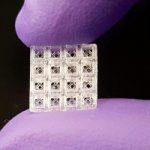Crop-Pollinating Robotic Bees
Do you know robotic bee could help pollinate crops as real bees decline
About three-quarters of global crop species, from apples to almonds, rely on pollination by bees and other insects. But pesticides, land clearing and climate change have caused declines in many of these creatures, creating problems for farmers. Pollination is needed for reproduction in flowering plants. Male flower parts, or stamens, produce pollen that fertilises female parts, known as pistils, to make seeds. In self-pollinating flowers, the stamen sheds pollen directly onto the pistil. Cross-pollination, however, requires the transfer of pollen from one plant to another. This mostly relies on pollen becoming stuck to the bodies of bees and other insects when they feed on flowers, and then being deposited on the next plant they visit. It has advantages over self-pollination, in that it increases genetic diversity and improves the quantity and quality of crops
Eijiro Miyako at Japan’s National Institute of Advanced Industrial Science and Technology, and his colleagues have used the principle of cross-pollination in bees to make a drone that transports pollen between flowers
The manually controlled drone is 4 centimetres wide and weighs 15 grams. The bottom is covered in horsehair coated in a special sticky gel. When the drone flies onto a flower, pollen grains stick lightly to the gel, then rub off on the next flower visited.In experiments, the drone was able to cross-pollinate Japanese lilies (Lilium japonicum). Moreover, the soft, flexible animal hairs did not damage the stamens or pistils when the drone landed on the flowers
Ref: www.newscientist.com
This post is also available in: Persian




Leave a Reply
Want to join the discussion?Feel free to contribute!